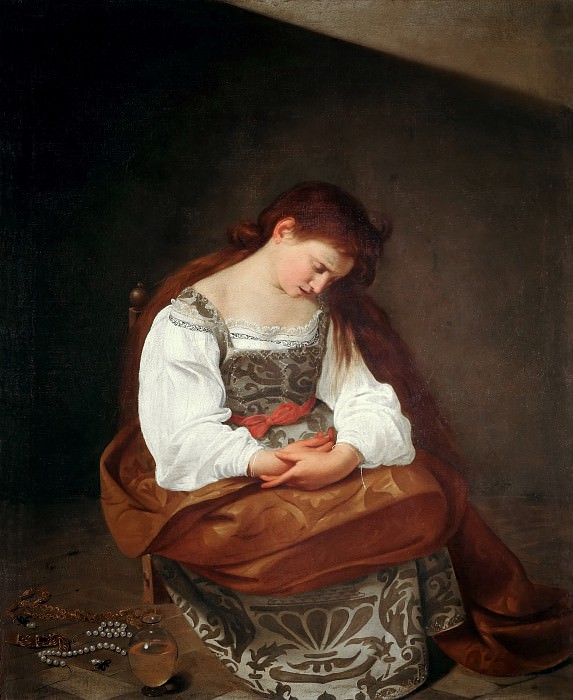Penitent Magdalene Michelangelo Merisi da Caravaggio (1571-1610)
Michelangelo Merisi da Caravaggio – Penitent Magdalene
Edit attribution
Download full size: 3662×4474 px (3,6 Mb)
Painter: Michelangelo Merisi da Caravaggio
According to historical accounts, one of Caravaggio’s deeply religious paintings, titled Penitent Mary Magdalene, was completed by 1597. Numerous biblical subjects particularly touched the soul of Baroque era sculptors. Italian painter Caravaggio created most of his masterpieces in Rome, then the center of art all over Europe. His famous Mary Magdalene was also painted in this city. By the rich gamma of the canvas and the skillful play of light instantly identifiable brush Caravaggio.
Description of Caravaggio’s "Penitent Mary Magdalene"
According to historical accounts, one of Caravaggio’s deeply religious paintings, titled Penitent Mary Magdalene, was completed by 1597. Numerous biblical subjects particularly touched the soul of Baroque era sculptors. Italian painter Caravaggio created most of his masterpieces in Rome, then the center of art all over Europe. His famous Mary Magdalene was also painted in this city.
By the rich gamma of the canvas and the skillful play of light instantly identifiable brush Caravaggio. The background of the painting is entirely painted with a dark brown tone. Only a small fragment of bright light falls from somewhere above on the corner of the painting. The figure of the artist’s heroine with the objects lying near her is also illuminated.
A young woman is sitting on a low chair in the center of the painting. She is wearing a silk white shirt. The corsage dress is decorated with damask ornaments. A long veil frames the figure of the heroine. Next to her on the floor are all kinds of jewelry: earrings, beads, and necklaces. Next to it there is a transparent jug of water. The girl after washing her thick brown hair.
Caravaggio masterfully shows the emotions of Magdalene. She folds her hands in front of her in helplessness. Her head is bowed and her eyes are closed. Yet he does not show remorse. Rather there is a hard resignation to the hardships of life, weariness and doom.
Even tears seem to run down her face, revealing all the bitterness in her soul.
The painter invited the maiden Anna Bianchini as his subject. She was a young sinful woman of sixteen, who because of need sold her body. She told the painter a difficult life story. And he found her image most suitable for painting The Penitent Magdalene.
The religious canvas was met with both criticism and praise. It can now be seen in the Italian capital, in the Doria Pamphili Gallery.
Кому понравилось
Пожалуйста, подождите
На эту операцию может потребоваться несколько секунд.
Информация появится в новом окне,
если открытие новых окон не запрещено в настройках вашего браузера.
You need to login
Для работы с коллекциями – пожалуйста, войдите в аккаунт (open in new window).














![Michelangelo Merisi da Caravaggio - Portrait of a Young Man [School]](http://cdn.gallerix.asia/j/C/438722921/6132.webp)





COMMENTS: 1 Ответы
Жёлтая ткань в данном случае – символ падшей женщины. Хотя таковой Мария Магдалина не была, в Библии это не упоминается. В 6 веке придумали, путали биографии её и Марии Египетской.
You cannot comment Why?
Her hands are clasped together, a gesture of prayer or humble submission. Beside her, scattered on the floor, are the symbols of her past life: a string of pearls, a jewel-encrusted necklace, and a small vial, likely containing perfume or anointing oil. These objects, once symbols of vanity and earthly pleasures, are now cast aside, signifying her renunciation of sin.
The background is dark and somber, with a shaft of light illuminating the figure from above, perhaps symbolizing divine grace or spiritual enlightenment. The overall mood is one of profound penitence, quiet sorrow, and spiritual awakening. The contrast between the opulence of her attire and the humility of her posture, along with the discarded jewels, underscores the theme of renouncing worldly possessions and seeking spiritual salvation. The painting captures a moment of deep personal reflection and transformation.